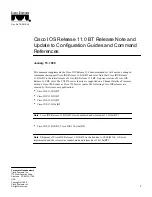
Table 9: OSPF-Related Terms
(continued)
Meaning
Term
OSPF LSAs are categorized into the following types:
■
Type 1—LSAs generated by an OSPF router for each area that it
belongs to. Type 1 LSAs are flooded to only a single area. These
LSAs carry information about directly connected links. Also known
as router LSA.
■
Type 2—LSAs generated by an OSPF designated router to describe
the set of routers in a network. Type 2 LSAs are flooded to the
area that contains that network. Also known as network LSA.
■
Type 3—LSAs generated by an ABR to describe inter-area routes
to networks outside of that area and internal to the AS; used for
route summarization. Also known as inter-area prefix LSA.
■
Type 4—LSAs generated by an ABR to describe inter-area routes
to ASBRs outside of that area and internal to the AS; used for
route summarization. Also known as inter-area router LSA.
■
Type 5—LSAs generated by an ASBR to describe links that are
external to the AS. Type 5 LSAs are reflooded from other protocols
into OSPF, and are flooded by OSPF throughout the routing
domain to all area types other than stub areas. OSPF sets the
forwarding address for a type 5 LSA when the next hop is directly
connected to the OSPF interface. Also known as AS-external LSA.
■
Type 6—Not supported.
■
Type 7—LSAs generated by an ASBR to describe routes that are
external to an NSSA. Type 7 LSAs are flooded only to NSSAs.
■
Type 8—Not supported.
■
Type 9—Opaque LSA with a link-local scope. Type 9 LSAs are not
flooded beyond the local network (local link).
■
Type 10—Opaque LSA with an area-local scope. Type-10 LSAs
are not flooded beyond the borders of their associated area.
■
Type 11—Opaque LSA flooded throughout the AS. Type 11 LSAs
are flooded throughout all transit areas, are not flooded into stub
areas from the backbone, and are not originated by routers into
their connected stub areas. Any type 11 LSA received in a stub
area from a neighboring router within the stub area is rejected.
■
Link LSA—OSPFv3 LSA that Provides the router’s link-local address
to all other routers attached to the link; informs other routers
attached to the link of a list of IPv6 prefixes to associate with the
link; enables the router to assert a collection of options bits in the
network LSA to be originated for the link
■
Intra-area prefix LSA—OSPFv3 LSA that associates a list of IPv6
address prefixes with a transit network link by referencing a
network LSA, or associates a list of IPv6 address prefixes with a
router by referencing a router LSA. The intra-area prefix LSA
includes the IPv6 prefix information that OSPFv2 includes in type
1 and type 2 LSAs.
LSA types
Routers that have interfaces to a common network.
neighboring routers
A network that has no broadcast capability but supports more than
two routers.
nonbroadcast network
Similar to a stub area, but can also import selected external LSAs.
Not-so-stubby area
(NSSA)
244
■
Overview
JUNOSe 11.0.x IP, IPv6, and IGP Configuration Guide
Summary of Contents for IGP - CONFIGURATION GUIDE V11.1.X
Page 6: ...vi...
Page 8: ...viii JUNOSe 11 0 x IP IPv6 and IGP Configuration Guide...
Page 18: ...xviii List of Figures JUNOSe 11 0 x IP IPv6 and IGP Configuration Guide...
Page 20: ...xx List of Tables JUNOSe 11 0 x IP IPv6 and IGP Configuration Guide...
Page 26: ...2 Internet Protocol JUNOSe 11 0 x IP IPv6 and IGP Configuration Guide...
Page 228: ...204 Internet Protocol Routing JUNOSe 11 0 x IP IPv6 and IGP Configuration Guide...
Page 264: ...240 Monitoring RIP JUNOSe 11 0 x IP IPv6 and IGP Configuration Guide...
Page 438: ...414 Monitoring IS IS JUNOSe 11 0 x IP IPv6 and IGP Configuration Guide...
Page 439: ...Part 3 Index Index on page 417 Index 415...
Page 440: ...416 Index JUNOSe 11 0 x IP IPv6 and IGP Configuration Guide...
Page 454: ...430 Index JUNOSe 11 0 x IP IPv6 and IGP Configuration Guide...
















































